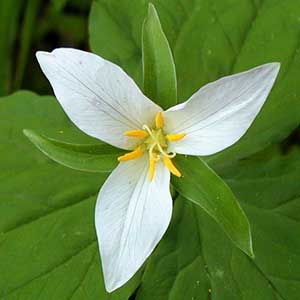Trillium ovatum
Trillium decumbens
Pacific trillium, trillium, western trillium, western wake-robin, western white trillium, white or western trillium, white trillium
decumbent trillium, trailing wakerobin
semierect to horizontal, short, stout, praemorse.
short, thick.
1–2, round, 2–5 dm, ± slender, glabrous.
1–2, decumbent, usually by an S-shaped curvature, round in cross section, 0.5–2 dm, somewhat stout, slightly expanded toward bracts, densely puberulent, especially just below bracts and on bases of main bract veins beneath.
sessile, subsessile, or short-petiolate;
blade medium green, sometimes blotched and mottled, main veins prominent, ovate-rhombic, 7–12 × 5–20 cm, continuing to expand during anthesis, base rounded, apex acuminate.
appearing early in season, in good condition for only a few weeks after anthesis, dying back to semipersistent bases early, resting on ground surface, sessile;
blade strongly mottled in shades of green and bronze and with silvery overlay, mottling becoming obscure with age, ovate to suborbicular, 4–12 × 3.3–7 cm, apex acute to rounded.
erect or nodding, odorless;
sepals spreading to horizontal, green, lanceolate to oblong-lanceolate, 15–50 × 6–20 mm, margins entire, apex acute;
petals erect-ascending, usually wide-spreading from base, exposing entire pistil, white or with pink or blush markings, lacking V-shaped markings, fading to rosy pink, purple, or dark red, veins not deeply engraved, ± linear to widely obovate, 1.5–7 ×1–4 cm, widest at or above middle, thin-textured, margins flat to undulate, apex acuminate;
stamens prominent, slightly recurved-spreading to straight, 10–18 mm;
filaments white, shorter than anthers, slender;
anthers yellow, 4–16 mm, slender, dehiscence latrorse-introrse;
ovary green or white, ovoid, 6-angled, 5–12 mm, attachment ± 3/4 ovary width;
stigmas recurved, barely connate basally, greenish white or white, linear, not lobed adaxially, 6–10 mm, uniformly thin;
pedicel erect to leaning, 2–6 cm.
erect, odor unreported;
sepals divergent, green- or maroon-streaked, lanceolate-ovate, 22–48 × 9–14 mm, margins entire, flat, apex acute;
petals long-lasting, rigidly erect, ± connivent, ± concealing stamens and ovary, dark maroon-purple when fresh, fading especially distally to dull reddish brown, greenish brown, or with creamy yellow tones, very rarely pale lemon yellow forms occur, twisted (but not spiraled), linear-lanceolate or oblanceolate, 4–8+ × 0.7–1 cm, thick-textured, margins entire, apex acute;
stamens erect, straight, dark purple, 10–25 mm;
filaments dark purple, 2–5 mm;
anthers straight, dark purple, 9–20 mm, dehiscence extrorse;
connectives broad, extending to 3.5–4 mm beyond anther sacs;
ovary dark purple, oval, 6-angled, 5–10 mm;
stigmas erect, divergent-recurved, distinct, sessile, pink or white, subulate, 4.5–8 mm.
baccate, green or white, ± odorless, broadly ovoid, obscurely winged, 1.2–2.8 × 0.7–1.9 cm, pulpy-moist.
baccate, dark purple, broadly ovoid to subglobose, crownlike, strongly ridged, 1–1.5 × 1 cm, pulpy but not juicy, present and enlarging on naked scapes until early autumn.
= 10.
= 10.
Trillium ovatum
Trillium decumbens
Varieties 2 (2 in the flora).
(Discussion copyrighted by Flora of North America; reprinted with permission.)
Trillium decumbens occurs in the Ridge and Valley and Cumberland Plateau physiographic provinces. It has a large, deep, horizontal rhizome, the growing point of which always faces downslope.
(Discussion copyrighted by Flora of North America; reprinted with permission.)
1. Bracts sessile; petals lanceolate to obovate, 1.5–7 × 1–4 cm | var. ovatum |
1. Bracts distinctly short-petiolate; petals linear to linear-lanceolate, 0.5–2.4 × 0.2–0.6 cm | var. oettingeri |
- Local floras:
BC,
CA,
OR,
WA
- Local Web sites:
CalFlora,
CalPhotos,
Flora NW,
PNW Herbaria,
Turner Photog.
WildflowerSearch
iNaturalist (observations)
USDA Plants Database
- LBJ Wildflower Center
- SEINet
- Plants of the World Online
- Encyclopedia of Life
- Wikipedia
- Google Image Search


